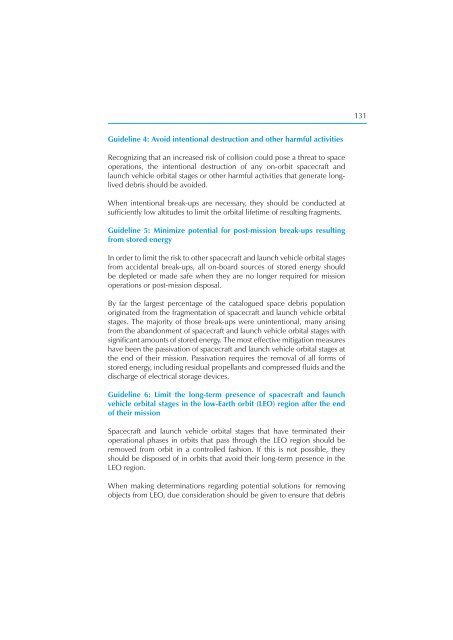Security in Space The Next Generation - UNIDIR
Security in Space The Next Generation - UNIDIR
Security in Space The Next Generation - UNIDIR
You also want an ePaper? Increase the reach of your titles
YUMPU automatically turns print PDFs into web optimized ePapers that Google loves.
Guidel<strong>in</strong>e 4: Avoid <strong>in</strong>tentional destruction and other harmful activities<br />
Recogniz<strong>in</strong>g that an <strong>in</strong>creased risk of collision could pose a threat to space<br />
operations, the <strong>in</strong>tentional destruction of any on-orbit spacecraft and<br />
launch vehicle orbital stages or other harmful activities that generate longlived<br />
debris should be avoided.<br />
When <strong>in</strong>tentional break-ups are necessary, they should be conducted at<br />
suffi ciently low altitudes to limit the orbital lifetime of result<strong>in</strong>g fragments.<br />
Guidel<strong>in</strong>e 5: M<strong>in</strong>imize potential for post-mission break-ups result<strong>in</strong>g<br />
from stored energy<br />
In order to limit the risk to other spacecraft and launch vehicle orbital stages<br />
from accidental break-ups, all on-board sources of stored energy should<br />
be depleted or made safe when they are no longer required for mission<br />
operations or post-mission disposal.<br />
By far the largest percentage of the catalogued space debris population<br />
orig<strong>in</strong>ated from the fragmentation of spacecraft and launch vehicle orbital<br />
stages. <strong>The</strong> majority of those break-ups were un<strong>in</strong>tentional, many aris<strong>in</strong>g<br />
from the abandonment of spacecraft and launch vehicle orbital stages with<br />
signifi cant amounts of stored energy. <strong>The</strong> most effective mitigation measures<br />
have been the passivation of spacecraft and launch vehicle orbital stages at<br />
the end of their mission. Passivation requires the removal of all forms of<br />
stored energy, <strong>in</strong>clud<strong>in</strong>g residual propellants and compressed fl uids and the<br />
discharge of electrical storage devices.<br />
Guidel<strong>in</strong>e 6: Limit the long-term presence of spacecraft and launch<br />
vehicle orbital stages <strong>in</strong> the low-Earth orbit (LEO) region after the end<br />
of their mission<br />
<strong>Space</strong>craft and launch vehicle orbital stages that have term<strong>in</strong>ated their<br />
operational phases <strong>in</strong> orbits that pass through the LEO region should be<br />
removed from orbit <strong>in</strong> a controlled fashion. If this is not possible, they<br />
should be disposed of <strong>in</strong> orbits that avoid their long-term presence <strong>in</strong> the<br />
LEO region.<br />
When mak<strong>in</strong>g determ<strong>in</strong>ations regard<strong>in</strong>g potential solutions for remov<strong>in</strong>g<br />
objects from LEO, due consideration should be given to ensure that debris<br />
131








